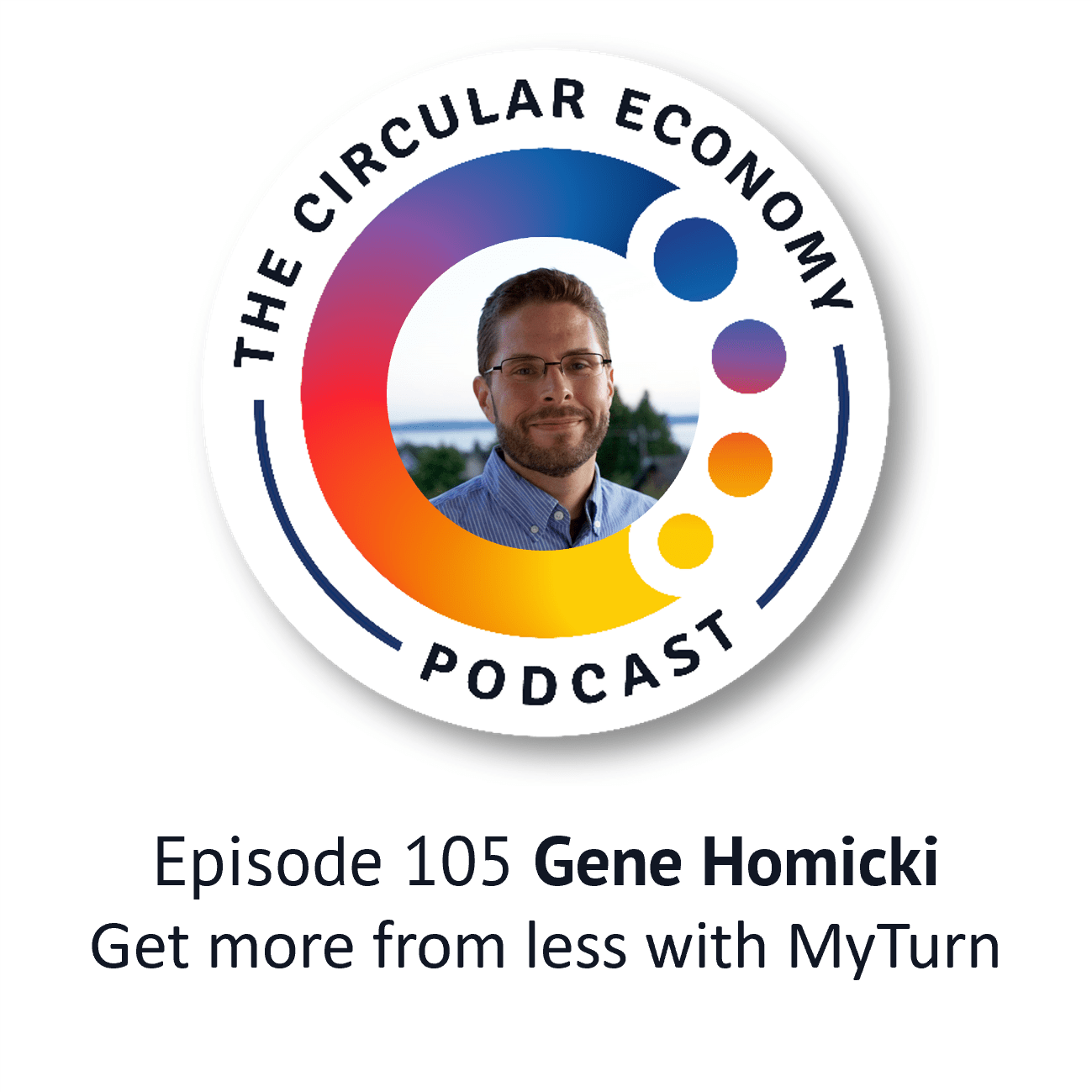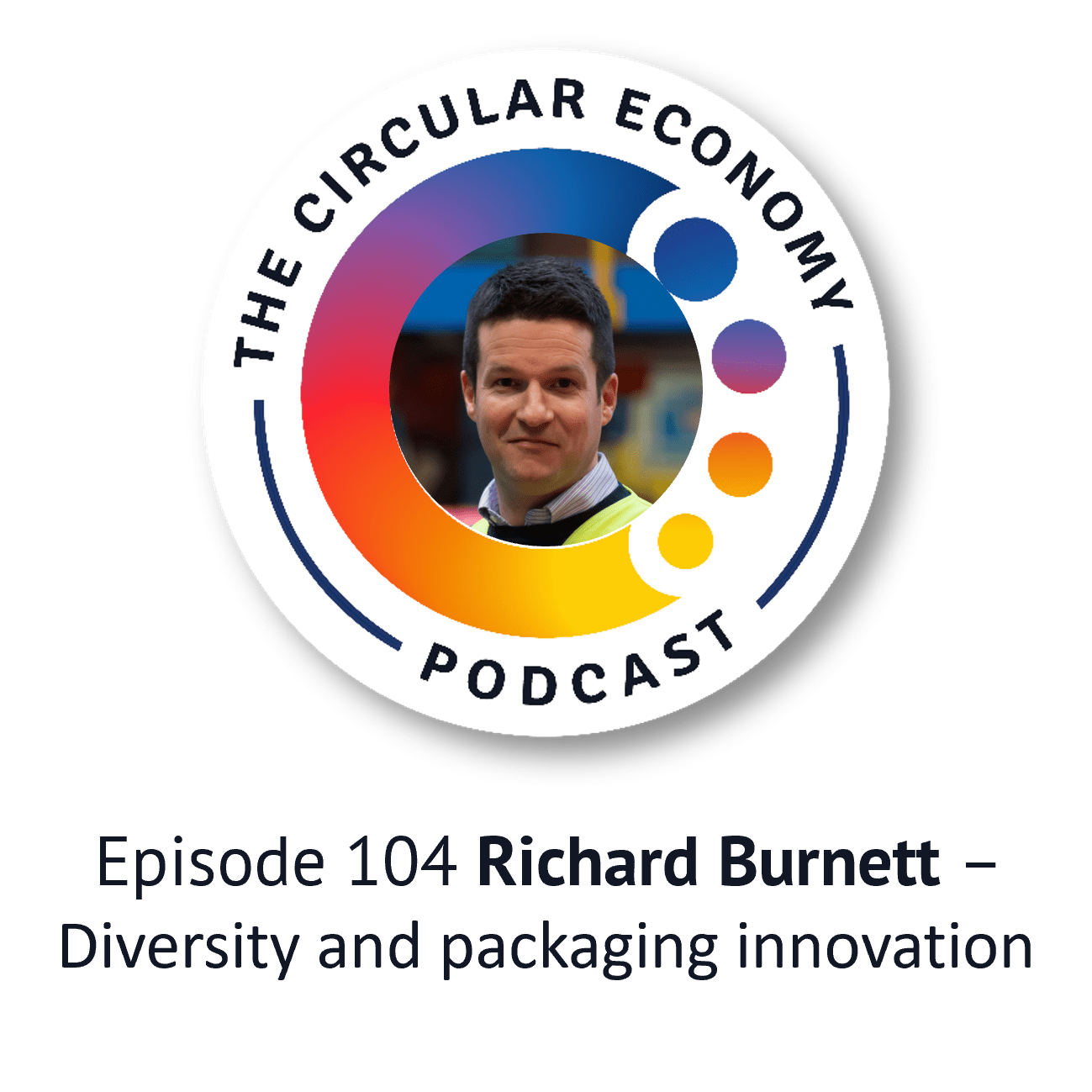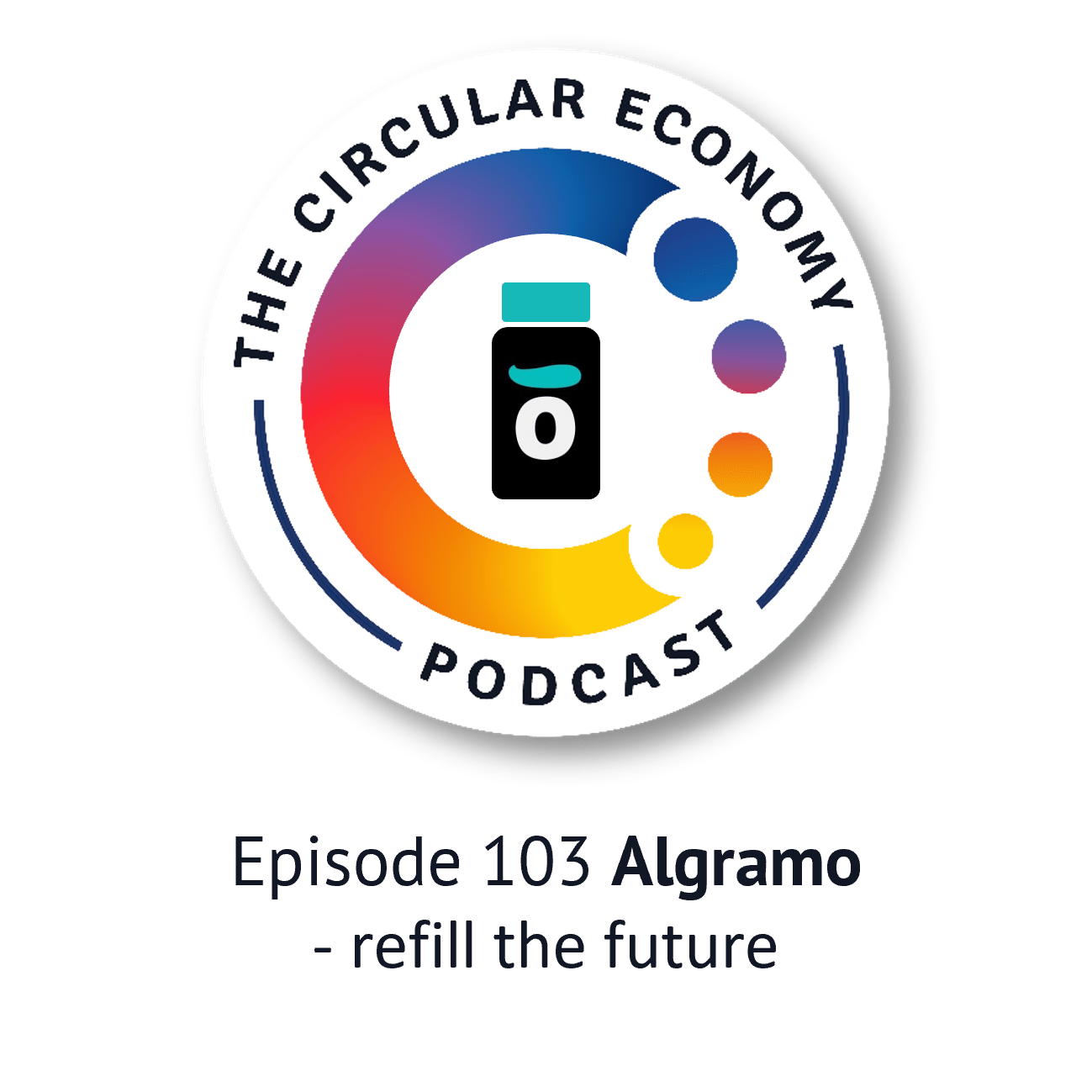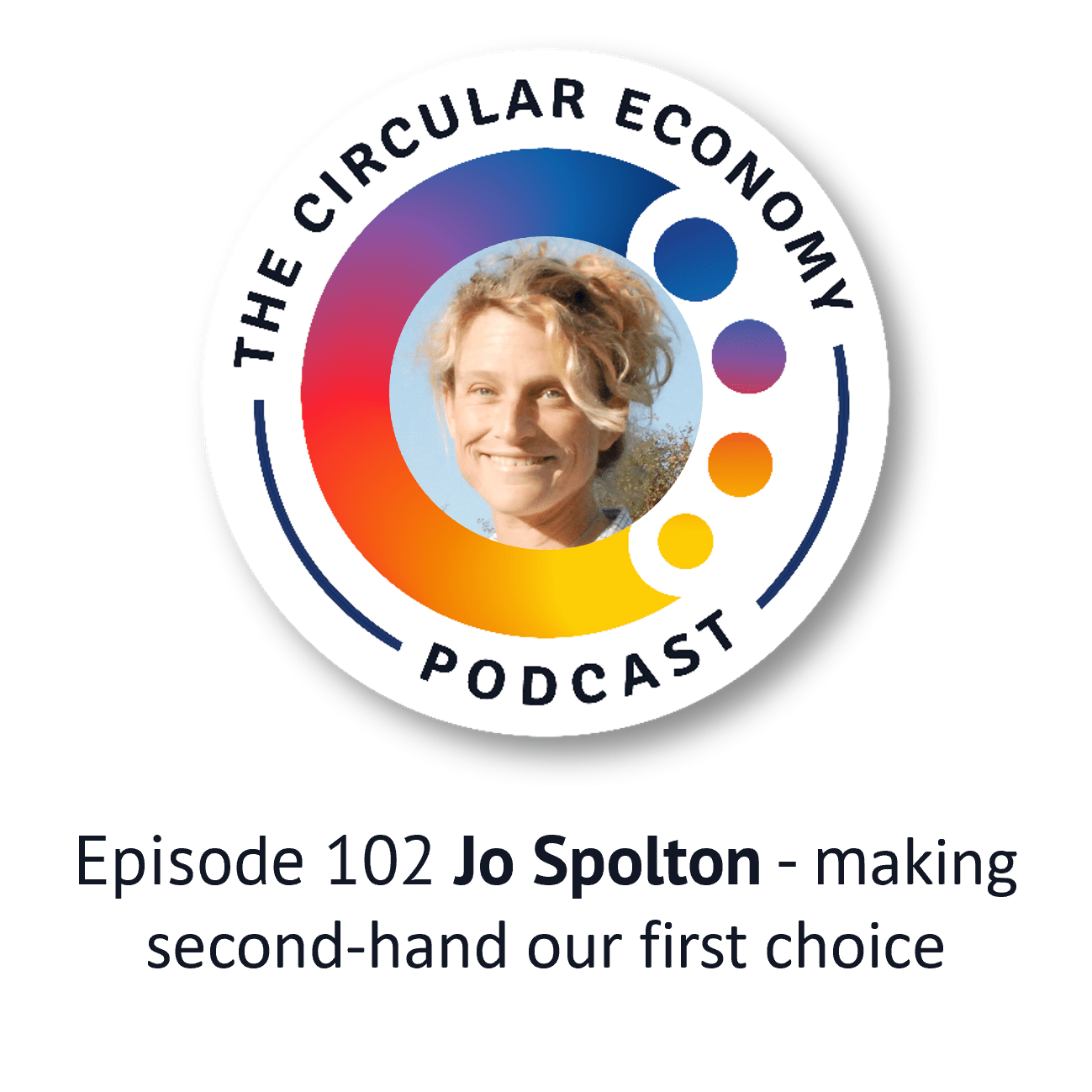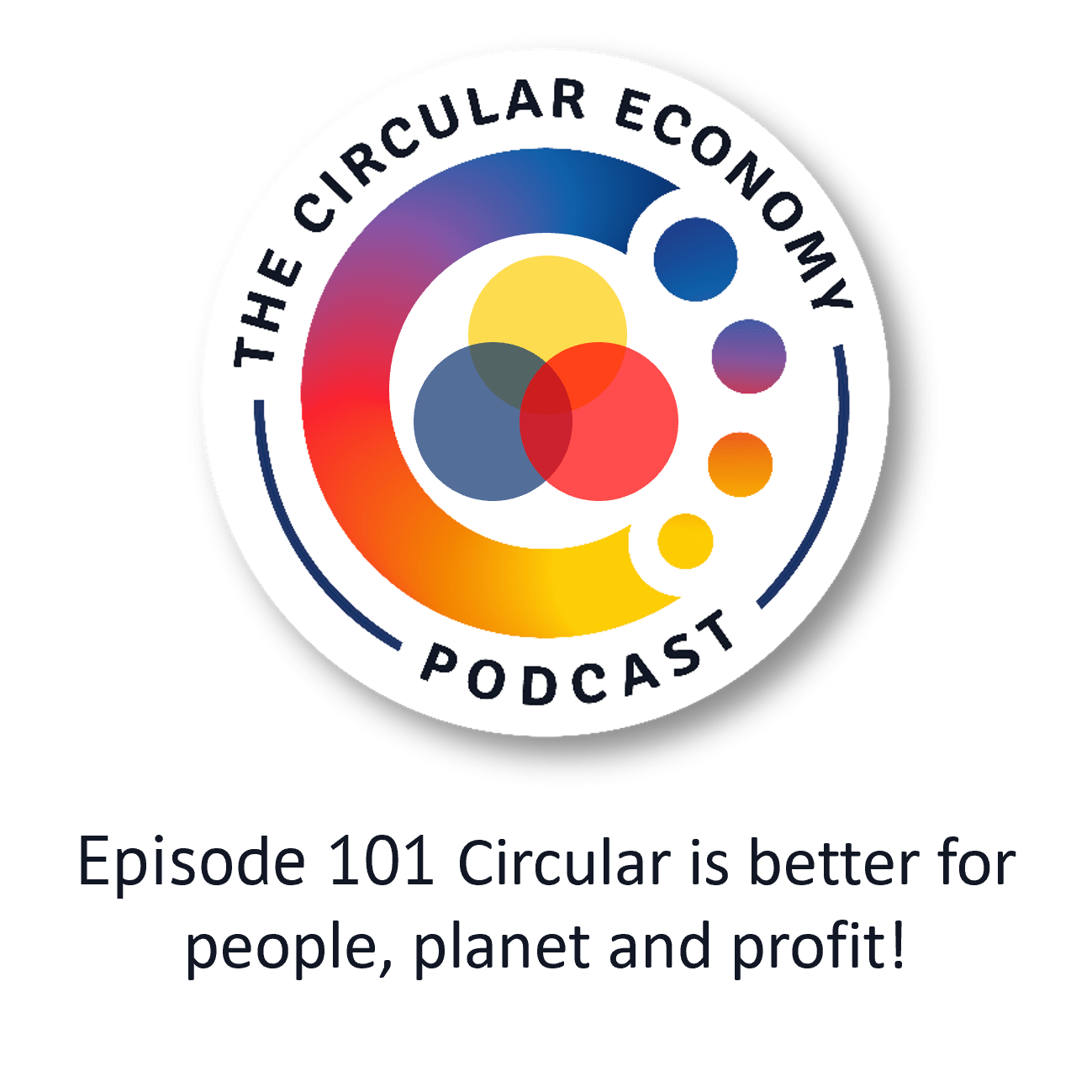Podcast: Play in new window | Download
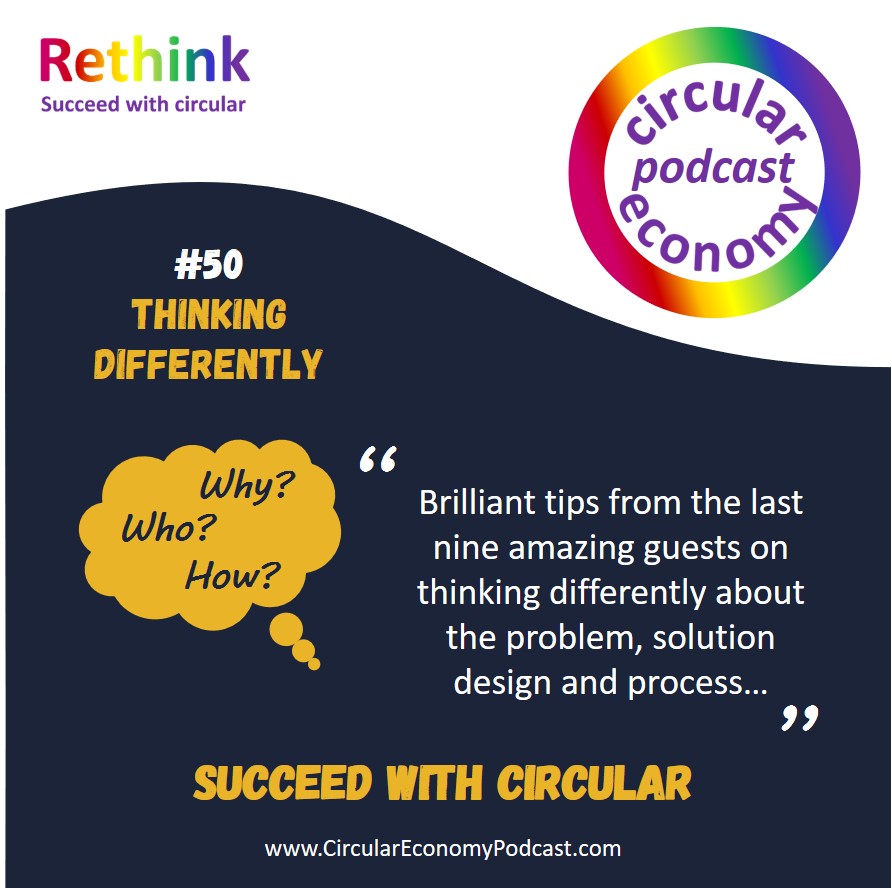
In this season, we’ve featured another 9 amazing, talented people, helping to make the circular economy happen. Our guests have been from the USA, Chile, Ghana, Spain and the UK.
We’ve heard valuable insights, shared by people working in startups, in well-established companies, and working to support those with new ideas, or to make existing businesses more circular. And yet again, I’m struggling to fit all the brilliant tips and lessons learned into this round-up episode.
A recurring theme was the advice to use different ways of thinking. You can link up with people from outside your organisation, you can use different design perspectives, like biomimicry, lean innovation or systems thinking, and you can develop your own process to help you think about the complete cycle, as we’ll hear later.
We’ve chosen highlights on how thinking differently can help you succeed with circular from:
- Sandra Goldmark, author of Fixation: how to have stuff without breaking the planet,
- Brian Bauer of Algramo,
- Richard James MacCowan of Biomimicry Innovation Lab,
- Tamsin Chislett of Onloan,
- Peter Desmond of the African Circular Economy Network,
- Gary Giles of OGEL, Joanna Bingham of Footprints Africa,
- Paraskevi Fotoglou from Camira Fabrics,
- Ryan Edwards of Naked Innovations.
Read on for a summary of the podcast and links to the people, organisations and other resources we mention.
You can subscribe to the podcast series on iTunes, Google Podcasts, PlayerFM, Spotify, TuneIn, or search for “circular economy” in your favourite podcast app. Stay in touch to get free insights and updates, direct to your inbox…
Links we mention in the episode:
- A Circular Economy Handbook: How to Build a More Resilient, Competitive and Sustainable Business – buy from any good bookseller, or direct from the publisher Kogan Page, which ships worldwide (free shipping to UK and US) and you can use discount code CIRCL20 to get 20% off: https://www.koganpage.com/CircEcon2 It’s available in paperback, ebook and on Kindle. If you buy it from online sources, make sure you choose the new edition with an orange cover!
- Catherine’s Blog: Through the lens of this pandemic, is your business providing what the world needs? Use ikigai principles to align your business purpose for people, planet & profit. https://www.rethinkglobal.info/ikigai-business-purpose/
- Dr Edward de Bono’s 6 Thinking Hats http://www.edwarddebonofoundation.com/Creative-Thinking-Techniques/Six-Thinking-Hats.html
- Ep 5 – Katie Beverley – Ecodesign https://www.rethinkglobal.info/episode-5-katie-beverley-ecodesign/
- Ep 6 – Adam Fairweather – reimagine waste https://www.rethinkglobal.info/adam-fairweather-reimagine-waste/
- Episode 16 – Sophie Thomas of Thomas Matthews https://www.rethinkglobal.info/episode-16-sophie-thomas-of-thomas-matthews-ltd/
Interview Transcript
Provided by AI
Catherine Weetman 00:03
Hello, and welcome to the Circular Economy Podcast, where we find out how circular approaches are better for people, planet and profit. I’m Catherine Weetman, of Rethink Global. And I’ll be chatting with those people making the circular economy happen. rethinking how we design, make and use everything. We’ll talk to entrepreneurs and business owners, social enterprises and leading thinkers. You’ll find the show notes, links and transcripts at a circular economy podcast.com where you can subscribe to updates and our fortnightly edition of circular insights.
Catherine Weetman 00:50
So here we are at Episode 50. I’m recording this on Friday, the second of April. And it seems a long time since starting this a couple of years ago, after too many months of procrastination. In the last season, we featured another nine amazing talented people helping to make the circular economy happen. Our guests have been from the USA, Chile, Ghana, Spain and the UK. We’ve heard valuable insights shared by people working in startups, and well established companies and working to support those with new ideas, automate existing businesses more circular. And yet again, I’m struggling to fit in all the brilliant tips and lessons learned into this roundup episode. Don’t forget, you can share your suggestions for what you’d like to hear more about, or topics and sectors you’d like us to cover. Just email us at podcast at rethink global dot info. A recurring theme was the advice to use different ways of thinking. You can link up with people from outside your organisation, you can use different design perspectives like biomimicry, lean innovation or systems thinking. And you can develop your own process to help you think about the complete cycle. As we’ll hear later. In several episodes, we heard about the importance of identifying a clear need for what you’re developing, and making sure that fits with the underlying purpose of your organisation. Purpose is your why. Why are you doing this? What’s getting you out of bed every morning? What difference Do you want to make in the world, you might have heard of the Japanese philosophy called Ikigai, generally used to help people find meaning in their lives. A while ago, I wrote a blog, translating that into a business perspective. I’ll put the link in the show notes at circular economy podcast.com. In Episode 47, we heard from Joanna Bingham, who set up Footprints Africa, in Ghana, to help small businesses and entrepreneurs to use the circular economy to help develop sustainable, scalable and inclusive approaches. footprints focuses on supporting local economies, and Joanna told us about the motivations of young people to make a positive difference.
Joanna Bingham 03:13
So with regard to those who, who are learning about circular economy, there is a lot of excitement. There’s there’s definitely a desire, especially among young people to have meaning in their roles and to make a difference in the in the community around them. So there’s a lot of youth led activism, and an idea of kind of entrepreneurship as a root out of any of problems, be those environmental or monetary.
Catherine Weetman 03:41
In Episode 49, Ryan Edwards of Naked Innovations told us about the importance of focusing on what the customer the end user really wants.
Ryan Edwards 03:53
With EIT food, the European Institution of Innovation, Technology for food, and they’ve done their research, and we’ve done our research to make innovations. We’ve worked with over 200 startups and last couple of years. And it’s become clear that reasons why some startups fail is they’re too focused on the technology. So we tried to re envision that and we use use something called design thinking or human centred design approach. And so let’s stop focusing on the technology solutions. Let’s understand what the demand what the consumer what the end user wants. And on that journey, we realised, yeah, bringing in fresh perspectives of different stakeholders and understanding their needs was was key by and making sure that we attached that work to the user. What does our customers actually want from us? What are their customers and consumers demanding and bringing light into that into that story?
Catherine Weetman 04:49
Some of our guests have tackled problems that might seem insurmountable. I’d heard about the Chilean startup Algramo a few years ago. And so I was over the moon when Brian Bauer who leads on circular economy and alliances at Algramo agreed to be on the show. Let’s hear Brian explaining the why for Algramo.
Brian Bauer 05:08
So Algramo’s a seven year overnight success story. So if we rewind seven years ago, Jose Manuel Moeller founded Algramo. And the reason he found it is because he was he came into a situation that created a complex problem for him in his roommates and his community around him. And he wanted to do something about that problem. So a little context on that is he he was living with his family. And he was around 20 years old at the time, and he wanted to move out and move in with some friends as since he was a university student. He was studying economics in business. And they moved out and moved out into the workforce because they didn’t have a lot of financial liquidity. They had to move into low income area. And things changed a lot for him when he did that, and one of the big changes was he was in charge of buying food. And the way that people typically buy food in Latin America, and much of the developing world for that matter, is if they’re in the bottom of the pyramid is they buy from small family or neighbourhood stores and they buy in really small formats. So if you live in a developed area, and you have financial resources you typically buy in larger format. So we’re still we’re talking about a a one litre two litre three litre size, but in these marginalised low income areas, people are forced to buy in very small quantities. And that leads to pain about 30 to 40%, more on a per unit basis for that product. And Jose Manuel put a name on that he called it the poverty tax. So our grandma came into existence to solve that poverty tax. And there’s some there’s kind of a nexus between the poverty tax and plastic pollution. And that is, there’s two key drivers there. One is if you live in an underdeveloped area, there’s typically less waste management facilities to capture waste. And then the other thing is when you The smaller the format the pocket you does, the more likely it is to escape into the environment or places that shouldn’t be. So Algramo came into existence to address those two interconnected issues.
Catherine Weetman 07:09
We heard about a different, but also a seemingly insurmountable problem to solve. When we spoke to Gary Giles, founder of OGEL in the UK, Gary and his former boss were trying to make reusable sandbags for flood defences. However, they quickly realised that whilst the reusable idea was great, they still had to figure out how to join the sandbags together. In trying to build a watertight wall, they’d arrived at the age old construction problem. How would you build a wall without using something to glue or hold the identical parts together? they solved the problem by going back to how they learnt to build as children using Lego bricks. While she can effectively join Lego from above and below, he can’t join two blocks side by side. they realised that instead of blocks, they could make l shapes which could be stacked facing up or facing down. Those l shapes would make a modular building block that could then lock together and provide robust structures of any shape and size and requiring no fixings or cement. Gary also highlighted the need to be clear on who your customer is. You might have just solved an age old problem. But who needs that solution? Is there a customer base, a market for your product or service? And is that market wide enough for you to find customers? You might need to think differently when working out how to find your market and your customers. Traditionally, you might use demographics to classify customers by age, whether they’re married or single, where they live, and so on. Now, though, you can get more sophisticated, using psychographics and even ethnography to understand your customers values there Why?
Catherine Weetman 08:59
In Episode 44, we talked to Tamsin Chislett, co founder of fashion subscription company Onloan. Tamsin explained how Onloan’s customers are value driven and love fashion, but want to work with businesses that care and that are not that are honest about where they are now versus where they want to get to. Tamsin also reminded us that studies show were happier when presented with fewer choices, not more. We want an interesting variety, so we can make choices, but we don’t want to have to scroll through endless pages of stuff. You should also consider what else your customer might need from you.
Catherine Weetman 09:40
In Episode 48, Paraskevi Fotoglou, sustainability engineer at Camira fabrics reminded us that customers often have needs that go beyond the technical features of the product itself. For Camira Fabrics, that means transparency. Customers want to know what’s in the textile, where and how it’s made. What certifications it has, and so on. And those customer needs could originate from different ends of the spectrum. Joanna Binghram explains what we might describe as two forms of circular economy, circular by default, where resources are expensive or scarce. And so people are more inclined to keep them in circulation, and avoid wasting those critical products or resources. Professor Walter Stahel calls this the circular society. And the other form would be circular by design, where we recognise the multiple problems caused by extraction and waste. And so we aim to resolve that by designing circular approaches to keep things in the system.
Joanna Bingham 10:43
I think that there’s there’s two types, there’s two types of people in the world. There’s two types of kind of people engaging the circular economy. So there and I forget someone, some I’m using someone else’s terminology, so apologies for not referencing them. But there are those who are who are operating in the circular way through necessity. So they have scarce resources, they, you know, you can get anything repaired in Ghana, I feel like if something’s broken, I just have to find someone in the in who knows someone who put me to someone who will be able to repair it. So those practices are just much more commonly adopted and, you know, traditional practices of using banana leaf to wrap your food in, for example, when you get takeout rather than plastic. And a lot of those things exist. But then there’s this kind of circular economy by by innovation, and by what I mean, they’re both innovation, but and it’s more known as a concept in thinking about Okay, how do I embed circular economy principles and as a knowledge of circular economy, and both both exist?
Catherine Weetman 11:46
When you move on to design the solution, again, the advice is to think differently. Try to look at the problem through different lenses. Does it still make sense? One way to do that is to use Dr. Edward de Bono’s six thinking hats. I put a link in the episode show notes at circular economy podcast.com. Are there other ways to design this or to solve the problem? Have you made positive differences for both people and planet? One approach that uses a different lens is biomimicry. In Episode 43, I spoke to my good friend Richard James MacCowan, founder of the Biomimicry Innovation Lab based in York in the UK. Richard started off by explaining what biomimicry is.
Richard James MacCowan 12:35
So, biomimicry is really about understanding how nature solves problems, and then translating this into our technical challenges were trying to overcome. It could be in management structure, all the way down to material science, engineering, computers and things like that. And the way I approach it is very much looking at a systems perspective. First off, so let’s look at biological system, living systems, ecological systems, ecosystems, and then working down into the processes the processes, looking at your thermal regulation, service, self organisation, and then finally, you’re looking down at individual functions, but then looking at how they’re actually interlinked. So if you start off that way, by looking at really at the trade offs, and relationships between everything, they’re not steps all the way back up to systems again.
Catherine Weetman 13:24
And in A Circular Economy Handbook, I unpack a few of these different ways of thinking in the chapter on Enablers and Accelerators, including a section on biomimicry from Richard, and another section on ecodesign from Katie Beverley, of PDR in Wales. Back in Episode Five, I talked to Katie about eco design, and Katie explained how this differs from circular economy approaches. Katie also told told us about human centred design. Ryan Edwards of Naked Innovations who we heard from earlier, thinks combining human centred design and circular design is the way forward
Ryan Edwards 14:04
about three and a half years ago, we created Naked Innovations, the leadership team from AllFoodExperts decided to refocus on this healthy planet Healthy People aspect. And we sort of took design thinking, which is human centred design, as I said, and take circular design, also known as kind of planning design, which is more recent, and actually put them together and say, You know what, we want to focus on projects that are understanding the needs of both planet and people. Because often, if you’re designing for people, you will end up designing something in the food industry that is cheap, that tastes good, and is really convenient. And often those three things are not in alignment of what the planet’s needs are and the resources. And if you designed something just focus on the planet, we found that often the sustainability departments of companies are very idealistic. And the product they make often is not a hit on the supermarket shelves, and they don’t get the market share that you’d like them to have. So we really realised that there was a gap there. And that’s where we we’ve really focused. And what we do is we tried to always start with the challenge. So often our clients come to us and say, hey, we’ve got this really cool solution, this new technology that we want to take to market, can you help us? We always push them to say, let’s take a step back? Why are you building this technology? Why do you think there’s a solution needed, what’s really the challenge you’re trying to solve? And then we’ll explore the options when we understand what their challenges and then we bring together right diverse stakeholders to try and solve it. So it’s much more likely to be successful and adopted in the market.
Catherine Weetman 15:51
Often, when we’ve interviewed people with design expertise, they’ve talked about the need to design for emotional durability as well as physical durability. Adam Fairweather, back in Episode Six, and Sophie Thomas in Episode 16 both explained how they approach that in Episode 41 Sandra Goldmark author of fixation, how to have stuff without breaking the planet, shared some of the underground research she’s been doing. One of Sandra’s questions was why we want to repair things, it’s a become important to us. Even though they may have little monetary value. Sandra loved food writer Michael Pollan’s rules for food, eat food, not too much, mostly plants. And she riffed on those to come up with our own guidelines for stuff, have good stuff, not too much, mostly reclaimed, care for it, pass it on. One way of ensuring things are more useful, and so more likely to meet someone’s needs is to design things to have multiple purposes. Patagonia, the outdoor gear brand aims to do this with its designs, so you don’t have to buy several different waterproof jackets, but you could use the same one for skiing, your commute to work, cycling and so on. Gary Giles explained how the OGEL blocks enabled a wide range of uses for the buildings. The recycled styrene has inherent insulation properties. The OGEL standard block can be used for walls, roof, for window and door fitment, and so on. And the finished buildings can be used for a wide variety of needs. Everything from humanitarian shelters, to working from home garden cabins. Another aspect of circular economy design, why you need to think differently is to consider the big system scale picture. And especially what happens to your product at the end of use. What’s the next life for the product components and materials? Gary Giles told us about his approach, what he calls a “full stop product”.
Gary Giles 18:07
Look at treated as initially, how you would deal with any product you got. Is there a need? So is it still? So is there a need? is a basis that it couldn’t be wide enough? And then the final question should always be is okay, I know this, I know that there’s a need. And there’s a market now, sort of, sort of before I even sort of put pen to paper or try and design this product, how can I then recycle or what I’m about what I’m thinking about making? So it becomes sort of the last step, but it’s all part of the same process? You know, so sort of get it right in the end the design stage. Because if you go at the design stage, and you think about all the possibilities and offerings that can go wrong, and how are you going to recycle it and reuse it and give it greater lifespan, then then you design out hopefully the worst problem of or certainly minimise the waste problem. And the final thing I would say is, is is do what we try to do and design what we call a full stop product, ie a product that never needs to be recycled because its lifespan. You’re building the real you’re building the usability, you’re building longevity into the products, ie It never has to be recycled. So try and build a full stop product.
Catherine Weetman 19:35
Fantastic. A new a new phrase for circular economy enthusiasts all over the world full stop products. Excellent. Thank you, Gary. We also heard excellent advice for going operational, particularly the importance of working out suitable funding and managing cash flow. In Episode 45, we heard from my friend and colleague at Rethink Global Peter Desmond who’s also a co founder of the African circular economy network. Peter uses his extensive experience in financial and business advisory roles to help organisations of all shapes and sizes with their circular journeys. patron I have put together some circular coaching packages. So you can get both of our perspectives on your ideas and challenges. If you want to know more, have a look at our coaching page at rethink global dot info. I asked Peter about his top tips for businesses wanting to go circular.
Peter Desmond 20:33
Well, unlike most accountants who don’t say very much, when asked questions like that, I do have a number of top tips. And they’re probably nothing new. But I would say, Get Started. If you want to do something, just get going. It’s like writing a dissertation. Just get writing, writing a book I imagine, Catherine. Yeah. But also, to read a lot about the circular economy. There is a lot out there, quite accessible. It’s not all academic, I’d also suggest people learn from the mistakes of others as best they can. People are also being a lot more honest now about their work, what it’s taken to get to where they are, I also find that it’s, it’s, it’s great to, to work and be encouraged by like minded people who are going to support you rather than put you off. And particularly in the longer term, I think you need to be resilient as an individual. And probably also as a business, if you are if you’re trying to develop new business models for your own company.
Catherine Weetman 21:39
And here is Joanna Binghamm, again, from Footprints, Africa, with her top tips. Joanna talks about iteration. And that’s an approach advocated by Eric Ries, author of the Lean Startup, Eric advises us to treat your experiments as the first product,
Joanna Bingham 21:57
a couple of things. One is protect your cash flow. Because if you can’t afford to run your core business, then you you know, you can’t afford to innovate. So I think making sure that your cash flow is protected. And then giving space to innovate in a kind of iterative way. So you know, work out what area you want to make a difference in and then try it in a small way. And basically, and, and then next, find awesome partners that you can work with to do it. So I think some of the challenges in in some African context is that you kind of, you have to do everything so easily. You mentioned around supply chains, for example, if you want to use innovative materials, or if you want to use regenerative materials, they don’t exist. So then you find yourself suddenly going and becoming a regenerative material manufacturer just because you wanted to build a roof. So, so I think finding, finding partners who can who can pick off different pieces of the puzzle, and working with them together. Is is powerful. And I think you know, for those, it’s really hard to get funding and get support for that innovative stage. And I think part of the challenges. Sometimes those who do get support for that innovative stage ended up being reliant on that support and not not focusing on the commerciality. So I think it’s so important that that this that there isn’t that donor dependence there isn’t that grant dependence that there’s always an item, making it commercially viable in whatever way as possible.
Catherine Weetman 23:30
Before you finalise your designs and plans, challenge yourself to aim high, how can you make it better and make a bigger impact? Can you include different ways of thinking by asking other people Ryan Edwards of Naked Innovations told us about the co founder matching system, now being rolled out at EIT Food through the new Team Up portal. Ryan then goes on to talk about why diversity of ideas and experience is crucial.
Ryan Edwards 24:00
Yeah, it’s the word that comes to mind I’ve used a few times is diversity. Really what I’m talking about there is empowerment. So I believe we need to listen more effectively and actively to different voices and empower those voices to speak up and share their concerns and share their ideas. And we do that by making the people sit around the table ensuring they’re more diverse and all the different ways all different forms of diversity and but not only for show but really asking them the pertinent questions and really listening to what how they answer and really then valuing those insights and doing something with it. It’s saying that I’ve believed my whole life and I see the power of it when it comes to driving innovation. And if we’re going to design a better world and I think we can design we design the world we live in so it’s through design, that is healthy planet healthy people. need to do it for the people by the people. See We need more diversity and to empower those people to share their insights and their concerns.
Catherine Weetman 25:07
Getting other people or organisations involved can be helpful all along the journey, not just at the startup or design phase. Tamsin Chislett told us how Onloan is choosing to partner with brands that already have a sustainability mindset. And going back to Episode 42, Brian Bauer at Algramo talked about their approach to collaboration. Algramo started off offering a white label reusable packaging system, and is now working with big brands like Unilever, Nestle, Clorox and Colgate with the aim of making a bigger impact. Brian, what are your lessons learned and top tips for other businesses wanting to either start something circular or go more circular?
Brian Bauer 25:51
That’s a good question. I think one critical thing is for circularity to thrive, it means it means like a diverse network of stakeholders supporting a circular ecosystem. So try and think about, try and think big and try and think from a systems perspective. And think about how strategic stakeholders can help you be successful. And in general, I find the circular economy movement is quite open to at least the high level pre competitive collaboration. So try and leverage stakeholders and people invested in making the circular economy happen to support your your growth.
Catherine Weetman 26:32
So we’ve heard from another group of inspiring people with a diverse range of backgrounds and skills, all focused on making a better world by thinking differently. They’re building products and services that add value to people, while aiming to reduce humanity’s footprint on our living planet. And ideally, to help regenerate resources, nature and society to let’s finish with a few words from Joanna Bingham of Footprints Africa.
Joanna Bingham 27:01
And circular economy has a huge potential to create uplift, you know, out of poverty, but also to create meaning for people because working for an organisation that stands for something is so has such a different it has such a transformation in your life and working with some of the companies that we do and seeing the change in mindsets and the kind of engagement of the staff of the companies that we’re working with is so amazing and often it comes from them listening to each other, and hearing each other better.
Catherine Weetman 27:39
That’s it for this episode of the circular economy podcast. If you like what you’re hearing, subscribe wherever you get your podcasts, leave us a review and tell your friends and colleagues. The circular economy podcast is brought to you by rethink global, helping you use circular, sustainable approaches to make a better world for people planet and your business. Get in touch via the website or connect with me on LinkedIn. If you’d like to learn more about the circular economy, why not go back and listen to Episode One, or buy the new edition of my award winning book a circular economy handbook how to build a more resilient, competitive and sustainable business, which takes you through the concepts and practicalities, including lots of real examples from around the world. Make sure you get the edition with the orange cover, which has a new chapter on packaging, lots of extra examples and updated research in every chapter. You can find resources and links mentioned in today’s episode, as well as a transcript of the conversation at rethink global dot info where you can find out how we help you succeed with circular
Want to find out more about the circular economy?
If you’d like to learn more about the circular economy and how it could help your business, why not listen to Episode 1, or read our guide: What is the Circular Economy?
To go deeper, you could buy Catherine’s book, A Circular Economy Handbook: How to Build a More Resilient, Competitive and Sustainable Business. This comprehensive guide uses a bottom-up, practical approach. It includes lots of real examples from around the world, to help you really ‘get’ the circular economy. Even better, you’ll be inspired with ideas to make your own business more competitive, resilient and sustainable.
Please let us know what you think of the podcast – and we’d love it if you could leave us a review on iTunes, or wherever you find your podcasts. Or send us an email…
Podcast music
Thanks to Belinda O’Hooley and Heidi Tidow, otherwise known as the brilliant, inventive and generous folk duo, O’Hooley & Tidow for allowing me to use the instrumentals from the live version of Summat’s Brewin’ as music for the podcast. You can find the whole track (inspired by the Copper Family song “Oh Good Ale”) on their album, also called Summat’s Brewin’. Or, follow them on Twitter.
